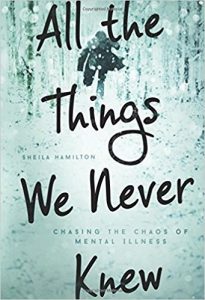2015
Memoir
$13.99; 312 pages
Seal Press
ISBN: 978-58005-584-0
Weaving a Narrative Case for Early Detection: Sheila Hamilton’s All the Things We Never Knew: Chasing the Chaos of Mental Illness
by Lisa Peterson
“It is my hope that my experience might serve as a cautionary tale for other people who are concerned about a loved one’s mental health.” – Sheila Hamilton
Radio and TV producer, reporter, anchor, and host, Sheila Hamilton, brings her probing investigative skills as a journalist as well as her own personal insights and vulnerabilities to her debut memoir, All the Things We Never Knew: Chasing the Chaos of Mental Illness. Hamilton immediately alerts readers to the territory she intends to explore by opening her introductory chapter with a summary of the storyline:
I missed much of the unfolding of my husband’s mental illness. By the time I’d pieced together the puzzle of who David actually was, he was falling apart. My once brilliant, intense, and passionate partner was dead within six weeks of a formal diagnosis of bipolar disorder, leaving my nine-year-old daughter and me without so much as a note to understand his decision.
Hamilton goes on to present grim statistics linking risk factors for suicide with the presence of mental disorders. Outcomes might improve, Hamilton postulates, if people were better informed about the signs of mental illness and treatments for brain disorders. She ends the introduction with the hope that her story, “will be a catalyst for positive change in the ways we approach, regard, and respond to the social fallout of mental illness.”
The narrative itself begins in medias res. Estranged from her husband, David, Sheila has already filed for divorce and is on a date when she receives an ominous phone call from the sheriff’s office. Instead of resting at home under his own mother’s watchful eye, David snuck out, drove to Larch Mountain, broke into a woman’s house, and stole her gun. Sheila is stunned. She knows his mental state is tenuous and now the police are considering him “armed and dangerous.”
With the stakes established and the tension raised, Hamilton drops us onto a page, set in different typeset, with the word STIGMA underlined at the top. Underneath, the text begins with: “According to the Substance Abuse and Mental Health Services administration, nearly one in five American adults (18.5 percent), or 43.8 million adults, had a mental illness in 2013.” The rest of the page emphasizes the persistent stigma surrounding mental illness as well as how David’s “sense of shame” exacerbated his particular case. These mental health informational interstices, inserted at the end of each chapter, can be a bit jarring. Yet we are also primed for them by our exposure to elements of mental dysfunction within the narrative. Often, the formality of these pages is mitigated by explicit links to David (as a person with mental illness), to Sheila (as the spouse and caregiver to a person with mental illness), and to their daughter, Sophie (as a child who has both witnessed her father’s illness and survived his suicide). These side-bar-like panels are clearly intended to be educational, providing facts, definitions, treatments, and resources regarding mental illness, but they also provide a break in the midst of a narrative that can feel heavy at times.
The next chapter returns readers to the beginning of Sheila and David’s story, describing the day they met in a coffee shop, with David “juggling construction plans and a pager while he ordered a double-shot cappuccino.” While at the time Hamilton was “immediately drawn to his erratic, discombobulated energy,” she briefly steps out of the narrative to tell us that, with the wisdom of hindsight, she interprets this behavior differently: “disorganization and anxiety are two of the early warning signs of bipolar disorder.”
As their relationship becomes more serious, David takes Sheila to meet his parents. He warns her that his father is “moody, charming, and complicated.” Sheila witnesses the manifestation of these varying moods within the first twenty minutes of meeting David’s father and we see hints of the genetic source of David’s illness. Here again Hamilton steps away from the narrative to make a retrospective comment: “Denial and mental illness are easy bedfellows, and in that first meeting and many others, David’s family gave no indication of a family history of mental illness. I would eventually learn David’s family history through his sister, a psychologist, and his medical documents, crucial pieces to a puzzle I’d tried to fit together for more than a decade.”
After meeting his family, Sheila and David enjoy some happy times together as they marry and have a daughter, Sophie. But their bliss is short-lived. Even while Sophie is still a baby, Sheila discovers David’s infidelity, leading Hamilton to comment, “Nothing would ever be the same again.” Indeed, the affair is just the beginning of a downward spiral of disorganization, deceit, and denial that grows as David’s illness continues to progress undiagnosed and untreated. By weaving together the narrative of what she experienced in the moment with reflective insights about David’s mental illness, Hamilton reinforces her thesis that if she’d been better informed, she might have pursued a formal diagnosis and treatment of David’s bipolar disorder before his life spiraled out of control.
Knowing what’s coming and armed with the information about mental health that Hamilton has provided us between chapters, we are able to see the signs that she herself, in the moment, cannot recognize. And even though we, as readers, know David will eventually commit suicide following his diagnosis of bipolar disorder, we keep hoping for an intervention that will save him. But as David’s behavior becomes more erratic and we watch the tragic cascade of his decline, we also begin to question ourselves—would I recognize the early warning signs if someone I knew was suffering from mental illness? And if I did, would I have the courage to act—even if that person was resistant?
Given Hamilton’s intention to not only share her story but also increase awareness and spur social change, her choice to weave personal narrative with educational panels proves effective. While primarily a work of literary nonfiction, the short interstices provide a guide of sorts—supplying readers with well-researched information about mental health and suicide. In addition, Hamilton includes a five-page listing of “Resource Organizations” as well as fourteen pages of “Notes” with citations from each chapter—clearly she has done her homework.
By delineating the narrative from the side bars through page breaks and typeset, the book can be approached in several different ways. For example, readers can progress sequentially, allowing the supplemental information to complement the narrative. Alternately, those who are most interested in Hamilton’s personal story can skip over the informational interstices. For people hoping to learn more about mental health issues, they can dive deeper into specific topics of interest using the resources at the back of the book. With all that said, it is important to remember that Hamilton’s story is but one case study—each individual’s experience will vary—and as with all health matters, it is important for readers to be their own health advocates: to explore their options, be informed consumers, consult with knowledgeable professionals, get second opinions, and participate in conversations with others facing similar challenges.
All the Things We Never Knew is a compelling personal narrative supplemented with informational panels on mental health issues, crafted by Hamilton via the lens of retrospection and the investigative skills of a reporter. Well-written, with both clarity and urgency, this book would appeal to anyone interested in or affected by mental illness or suicide—whether as a caretaker, family member, friend, or as someone who is living with a mental illness themselves.
Lisa Peterson is a serial career changer with titles that include professional ice skater, teacher, entrepreneur, researcher, game designer, and most recently, writer. Lisa has jumped from a plane, climbed Mount Fuji, and traveled to every continent except Antarctica. She holds two degrees from Stanford and is currently pursuing her MFA at Sierra Nevada College.



One more thing I would like to express is that as an alternative to trying to accommodate all your online degree lessons on days and nights that you conclude work (since most people are drained when they return), try to obtain most of your sessions on the saturdays and sundays and only 1 or 2 courses in weekdays, even if it means a little time away from your saturday and sunday. This pays off because on the weekends, you will be more rested along with concentrated in school work. Thanks a lot for the different points I have discovered from your blog site.